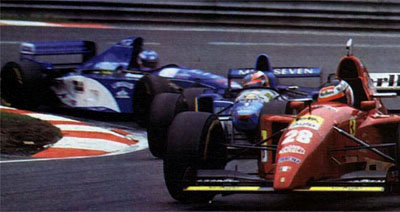|
F1 A.D. Specials - Pacific | ||||||||||
| Ľ PROFESSIONALISM COUNTS, BUT SO DOES CASHFLOW
Upon entering Formula One in 1994, Pacific Grand Prix team boss Keith Wiggins said: "I know that being successful in F1 takes a long time, but that's no reason for believing that you should be content to lose. Being professional, well organised and well presented does not require a lot of money, or even the best drivers. You can be one of the top teams in terms of professionalism, image and approach immediately."Someone should have reminded him that, regardless of how glamorous F1 is, and the exposure it gets, at the end of the day it's results that count. You don't get results if you don't have money, and no one cares how well-presented and organised you are. In its two years in F1, Pacific found this out the hard way. Ľ 2 YEAR OLD ENGINE, REYNARD CHASSIS No doubt that Wiggins knew how to organise a motor-racing team. In lower categories, when cars are relatively equal, organisational ability does count, and Pacific's record is second to none. With drivers like Harald Huysmans, Bertrand Gachot, JJ Lehto, Eddie Irvine and Christian Fittipaldi,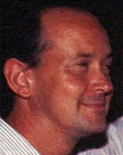 Pacific won the British and European Formula Ford and FF2000
championships in 1987, the British F3 title in 1988, and the International
F3000 championship in 1991. Pacific won the British and European Formula Ford and FF2000
championships in 1987, the British F3 title in 1988, and the International
F3000 championship in 1991.
By 1992, Wiggins (pictured right) wanted to move into F1, possibly in a partnership with Tyrrell, but this fell through. He then set his sights on bringing his own team into F1 in 1993, and made a deal to use Cosworth HB V8 engines. But after spending a million pounds, the recession hit, cheques bounced, and on the verge of bankruptcy, Wiggins had to wait another year. But nothing was going to stop Pacific entering in 1994. Wiggins signed an engine deal with Ilmor for 1992-spec engines which would nonetheless account for 40% of Pacific's budget. Chassis-wise, the team picked up the remnants of the Reynard design after plans for Reynard to enter F1 came to nothing. At the Pacific base in Thetford, Norfolk, Wiggins assembled a team which included Paul Brown as chief designer, Ian Dawson as team manager, Graeme Glew as commercial consultant, and Paul Owens as race engineer.
Ľ QUALIFIES AT BRAZIL ON OWN MERITS The Pacific PR01 chassis, which looked rather similar to a Benetton
with its raised shark-nose, ran on Goodyear tyres and used a Reynard
transverse 6-speed sequential gearbox. AP supplied the brake callipers,
and Carbone the brake discs and pads. The car used NGK But pre-season testing was ominous. There were installation problems with the Ilmor 3.5 litre V10, followed by a succession of failures from the powerplant. Tests revealed that the chassis had the structural rigidity of a paper bag. Put it another way: at the season opener in Brazil, Gachot qualified a respectable 25th, ahead of David Brabham's Simtek, while Belmondo didn't record a time. But although Gachot was taken out in a collision on lap 3, that weekend the team had done more miles than in all of pre-season testing.Indeed, the Brazilian weekend would be the only one in which Pacific even looked like having the upper hand performance-wise over fellow debutants Simtek. Usually, while the Simteks were on the pace of the Lotuses and Larrousses, the Pacifics would be some way back still. All things being normal, after the Pacific GP at Aida, when neither Pacific car could beat Roland Ratzenberger to the last grid spot, Wiggins must have realised that his team would hardly get on the grid all year.
Ľ INJURIES AND FATALITIES GIVE PACIFIC EXPOSURE But, in some ways luckily for Pacific, 1994 was not a normal year.
During the dreadful weekend at Imola, when Rubens Barrichello had
his accident on the Friday, that freed up a spot for Gachot, who duly
qualified 25th ahead of Ratzenberger. Though the Austrian was then killed
on the Saturday, Belmondo (pictured right) was not promoted up to
the last spot. Before the San Marino GP, Wiggins had actually done a sponsorship deal with the appropriately-named Death Cigarettes, which was meant to come into effect after Imola. It didn't take a genius to realise that this wasn't exactly in good taste after the events of the awful weekend, and as a result this potentially important deal came to nought. When Williams and Simtek did not run a second car at Monaco, both Pacifics were assured of starts. That both Saubers were then withdrawn after Karl Wendlinger's almost fatal accident in practice meant Gachot and Belmondo would be guaranteed 23rd and 24th spot on the grid. As it was , Gachot was over a second slower than Brabham, and Belmondo over 10 seconds behind Gachot and over 18 seconds off pole. (But, truth be told, Belmondo was usually close to Gachot's pace.) Gachot had a gearbox failure after 49 laps, and Belmondo suffered cramp and numbness which forced him out after 53.
Ľ FROM FRANCE ONWARD THE SUNDAY OFF
Now, for Canada, although Andrea de Cesaris filled the second Sauber seat, Montermini's absence meant that once again there would be at least one Pacific on the grid. As it turned out, Gachot beat Belmondo to 26th spot by just over 0.1s, but was still over a second off Brabham's Simtek. Another engine failure put paid to Bertrand's race after 47 laps. With normal service resumed from France onwards, Pacific never graced the grid in 1994 again. On good days Gachot might be within a second of the 26th spot, but usually they were a long way away. For instance, they were over two seconds off the grid in France, Germany and Italy. At Jerez, when it was thought that Gachot could beat newcomers Hideki Noda and Mimmo Schiattarella, the Italian's Simtek was about 1.5 seconds faster.
Ľ GACHOT GRATEFUL FOR END OF THE SEASON In Japan, even Taki Inoue's Simtek was over 1.3 seconds faster than Gachot, despite being over 3 seconds off Mika Salo's 25th placed Lotus. But, true to their word, Pacific had remained professional throughout. They kept plugging on and tried to make improvements. Although they had sold much of their aerodynamic data to Ligier, they searched in vain for innovations. They even dumped the high nose and reverted to a droop nose at the end of the season, to no avail. The car, simply, was a shocker, and Pacific's 1994 campaign was hopeless. In Belgium, they were given a garage between Benetton and Williams, the cynics saying that this allowed the big boys more space when Pacific packed up on Saturday night. At the season-ending meet in Adelaide, Gachot declared the Saturday to be one of the happiest days of his life, because he would never have to drive the PR01 again.
Ľ PARTNERSHIP WITH NEAR-DEAD LOTUS Yet Wiggins was sticking to his guns, and intent on making a better fist of 1995. He commissioned a new design from Frank Coppuck, Peter Ellingham and Geoff Aldridge, and over the off-season took over what was left of the Lotus team. For 1995, the team would officially be known as Pacific Team Lotus, but as the season wore on, most observers probably found it too cringe-worthy to associate Lotus with Pacific. All the same, when the PR02 was revealed, it had a new blue colour scheme with green striping that included the Lotus logo. More unusual was the weird 'tea-tray' that stuck out at the front of the nose. What aerodynamic purpose it was meant to serve was never made very clear, but in a year which also saw McLaren introduce its mid-wing, Pacific's tea-tray was aesthetically pleasing by comparison. The PR02 also had relatively high side-pods, and also a healthy list of little sponsors, including Interflora, Ursus, Icol, Hewlett Packard, Catamaran, Quest International, Bellerose, Kenwood, MIRA and Cargo Express.
Ľ MONTERMINI BRINGS CASH, STABILITY
Originally it was thought that Pedro Lamy would get the nod, but come Brazil, it was Andrea Montermini in the car. Though the Italian (pictured right) was not without ability, he was mainly in the team because he could help to pay the bills, not that he actually forked out much throughout the season. With Lotus and Larrousse gone, and only Forti entering, there were 26 entries per race, and the Pacifics were guaranteed of qualifying each time. It was a right-royal battle for mediocrity at the back of the grid between the Simteks, Fortis, Pacifics and Inoue's Arrows, although Simtek showed that they had quite a competitive car capable of running in midfield before they folded mid-season.
Ľ CUT-PRICE OPERATION SUFFERS INEVITABLE UNRELIABILITY Though Pacific had the upper hand in qualifying over the Fortis and Inoue early on, towards the end of the season they were more evenly matched, as Pacific's development ground to a halt. With so little money, Pacific limited running time to save mileage on the engines, and often stretched gearbox usage to breaking point. Brazil brought Pacific's best qualifying performance ever, Gachot just cracking the top 20, and Montermini starting 22nd, with the Italian bringing home Wiggins' first ever finish in 9th spot. Argentina then saw both cars eliminated within the first two laps by Wendlinger's errant Sauber, and the writing was on the wall. For the rest of the season, money would be an inherent problem, to the point where Gachot relinquished his seat mid-season so that others could waste their cash.
Ľ LET THE DONKEYS DRIVE Giovanni
Lavaggi obliged for 4 races, and gave a fair account of himself,
before the incomparable Jean-Denis
Deletraz filled the breach and amazed the world with his ineptitude.
You just have to read the story of his Portuguese GP to get a taste of it.
After Deletraz In terms of results, Pacific's season was blighted by gearbox failures. I count 10 in races all up. Their drivers also had a nasty habit of falling off the road and getting caught up in incidents. Montermini spun off in Britain, Lavaggi (pictured right) did likewise in Hungary and Italy, while Montermini was involved in a first lap collision in France, and race-stopping incidents in Italy and Portugal. Add to that a gamut of other reliability problems, and finishes were few and far between. For a team which prided itself on its organisational ability there was also an embarrassing mishap at Monaco, when Montermini was adjudged to have jumped the start. When given a stop-go penalty, the team took 5 laps to bring him in instead of the statutory 3, and Andrea was duly disqualified and shown the black flag.
Ľ ALMOST RESPECTABLE SEASON, ALL THINGS CONSIDERED
In the early wet conditions, with the McLarens struggling on slicks, Deletraz passed Mark Blundell for last, and Montermini got by Mika Hakkinen. Not that the team could tell him that on the pit board, because they never had the name 'Hakkinen' on hand! However, when Montermini came in, he ran over refueller Paul Summerfield, breaking Summerfield's leg, and promptly ran out of fuel. Pacific had done OK in their second season, gearbox notwithstanding. Those two 8th place finishes were stellar efforts, and would be the best in their F1 history. Though it was rumoured that for 1996 Pacific would have 1995 Yamaha engines badged as Judd powerplants, the truth was that Pacific simply didn't have any more money. Add to that there would be the new 107% rule for qualifying in 1996. Had it applied in 1995, then Pacific wouldn't have started most races. In this situation, Wiggins did the right thing and withdrew from F1 to count his (considerable) losses.
|
||||||||||
| back |

 spark plugs and Elf fuel. Pacific shareholder Bertrand
Gachot was to drive one car, while
spark plugs and Elf fuel. Pacific shareholder Bertrand
Gachot was to drive one car, while 
 Gachot narrowly avoided
Gachot narrowly avoided 
 There was no second Sauber in Spain, so at least one Pacific
would start. On the Friday, both Pacifics were faster than
There was no second Sauber in Spain, so at least one Pacific
would start. On the Friday, both Pacifics were faster than 

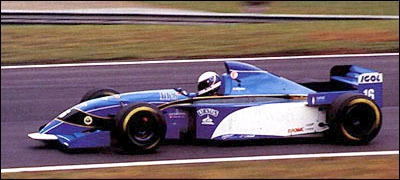
 On
the technical front, the awful Ilmors had been replaced with the more
reliable but equally slow customer Ford ED V8s. Bertrand Gachot would
remain on the driving team, but the other driver was a late choice.
On
the technical front, the awful Ilmors had been replaced with the more
reliable but equally slow customer Ford ED V8s. Bertrand Gachot would
remain on the driving team, but the other driver was a late choice.

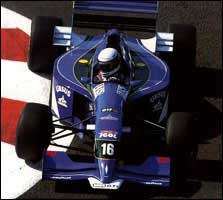
 defaulted on payment, Pacific wanted Katsumi Yamamoto to
drive in the Japanese races, and Oliver Gavin for Australia, but
neither were granted a superlicence, so Gachot was forced to resume
driving duties.
defaulted on payment, Pacific wanted Katsumi Yamamoto to
drive in the Japanese races, and Oliver Gavin for Australia, but
neither were granted a superlicence, so Gachot was forced to resume
driving duties.

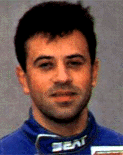 Other
than that, Montermini was not classified in France after finishing 10 laps
down, but did come home 8th in Germany and 12th in Hungary. Gachot was
12th in Britain and 8th in Australia, while Deletraz (pictured
left) dawdled home 15th at the Nurburgring. The European GP there
provided Pacific with highs and lows that summarised their season neatly.
Other
than that, Montermini was not classified in France after finishing 10 laps
down, but did come home 8th in Germany and 12th in Hungary. Gachot was
12th in Britain and 8th in Australia, while Deletraz (pictured
left) dawdled home 15th at the Nurburgring. The European GP there
provided Pacific with highs and lows that summarised their season neatly.
